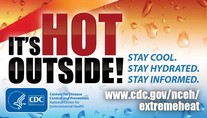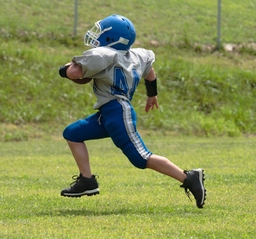Summer's Heating Up - Are You Ready?
Heat-Related Illness
Heat-related deaths and illness are preventable, yet annually many people succumb to extreme heat. Know the signs of heat-related illness and what to do when you notice them.
Heat exhaustion: heavy sweating; weakness;
cold, pale, and clammy skin; fast, weak pulse; nausea or vomiting; fainting
What to do: move to a cooler location; lie down and loosen
clothing; apply cool, wet cloths to as much of the body as possible; sip
water; seek medical attention if the person vomits and continues vomiting
Heat stroke: high body temperature
(above 103 degrees Fahrenheit); hot, red skin - dry or moist; rapid and
strong pulse; possible unconsciousness
What to do: CALL 911 immediately and follow the
operator's directions - this is a medical emergency; move the person to
a cooler place; reduce the person's body temperature with cool cloths or a
bath; do NOT give liquids
For more information, see CDC's Extreme Heat website.
|
Preparing for Extreme Heat
Free Training - Recognizing, Preventing and Treating Heat-Related Illness
This training was designed especially for coaches, school
nurses, parents, and others who train or provide athletic training in the
heat.
After completing this web based course, the learner should be
able to:
Continuing education credits available.
|
 |
Extreme Heat Media Toolkit
CDC's Extreme Heat Media Toolkit offers logos, Web banners,
posters, and more to help media, public health professionals, and others
share information about how to stay safe during extreme heat events.
|
Ready Wrigley Prepares for Extreme Heat - An Activity Book for Kids
Summertime is a great time to make sure your family is ready
for any kind of disaster. Kids can help Wrigley get her family ready to stay
safe during extreme heat. Find helpful tips to help children and adults avoid
heat-related illnesses too!
|
|
|
|
|


